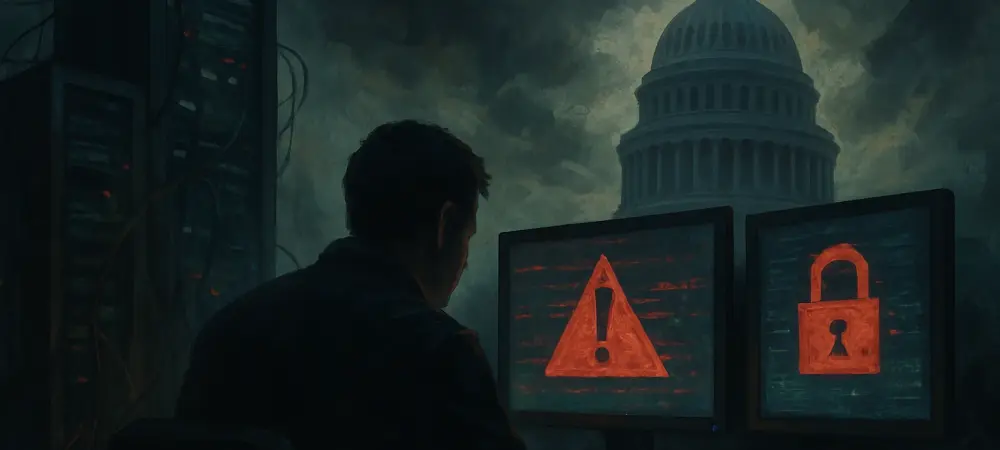Unveiling a Digital Crisis Amid Political Stalemate
As the U.S. government grapples with a prolonged shutdown, the nation’s cybersecurity landscape faces an unprecedented test, exposing critical weaknesses at a time when digital threats are escalating with alarming speed. With federal agencies like the Cybersecurity and Infrastructure Security Agency (CISA) operating on a skeleton crew and key operations stalled, the market for cybersecurity solutions and compliance is under immense pressure. This analysis seeks to dissect how the current political gridlock is reshaping the cybersecurity sector, impacting defense contractors, private industries, and national resilience. The stakes are high, as adversaries exploit these gaps with increasing sophistication, leaving businesses to navigate uncharted risks. By examining market trends, data, and projections, this piece aims to provide clarity on how the shutdown is altering the cybersecurity ecosystem and what it means for stakeholders across the board.
Market Dynamics: Cybersecurity Under Siege
Staffing Shortages and Rising Demand for Private Solutions
The government shutdown has slashed federal cybersecurity manpower, with CISA functioning at just 35% capacity, employing roughly 889 staff while thousands remain furloughed. This reduction translates into slower threat detection and delayed alerts, creating a ripple effect across industries reliant on federal guidance. As a result, the market for private cybersecurity services is witnessing a surge in demand, with companies scrambling to fill the void left by diminished government oversight. Managed detection services and commercial threat intelligence platforms are seeing increased adoption as businesses seek real-time data to counter risks that federal agencies can no longer address promptly.
This shift is driving significant growth in the private security sector, with projections indicating a sharp rise in contracts for endpoint monitoring and incident response over the next two years. However, the challenge lies in scalability—many smaller firms lack the resources to pivot quickly, while larger players face intense competition for skilled talent. The market is also seeing a spike in costs as service providers capitalize on urgent needs, potentially pricing out critical infrastructure sectors like energy and transportation that are already stretched thin. This dynamic underscores a pivotal trend: reliance on private solutions is no longer optional but a necessity in times of federal disruption.
Disrupted Intelligence Sharing and Market Fragmentation
Another critical market impact stems from the breakdown in public-private intelligence sharing, exacerbated by the expiration of key liability protections once provided by past cybersecurity legislation. Companies are now more hesitant to share threat data, fearing legal repercussions, which fragments the collaborative ecosystem essential for rapid response. This hesitation is stunting the growth of shared threat intelligence platforms, a market segment previously forecasted to expand by 20% annually through 2027. Instead, isolated silos of data are emerging, weakening overall market resilience and leaving smaller players particularly vulnerable.
The slowdown at the National Institute of Standards and Technology (NIST) further compounds this issue, as delayed framework updates and guidance hinder compliance efforts across sectors. For industries like healthcare and manufacturing, which depend on NIST standards for operational security, this creates a bottleneck in adopting new technologies and practices. Market analysts predict that prolonged delays could lead to a 15% drop in compliance readiness among mid-tier firms, pushing them toward costly third-party audits or risking penalties. The fragmentation of intelligence and standards is thus reshaping investment priorities, diverting funds from innovation to damage control.
Defense Contractor Pressures and Compliance Market Boom
The defense industrial base is experiencing unique market pressures due to frozen contracts and delayed payments during the shutdown, which threaten liquidity and talent retention. With the Cybersecurity Maturity Model Certification (CMMC) deadlines looming—Phase 1 starting November 10 this year and Phase 2 in 2026—contractors face unrelenting compliance demands despite federal slowdowns. This has ignited a booming market for CMMC consulting and assessment services, as roughly 80,000 contractors must align with NIST 800-171 standards to remain eligible for Department of Defense contracts. Current data suggests only 1% of these contractors are fully prepared, signaling a massive untapped market for compliance solutions.
Larger contractors are already leveraging higher Supplier Performance Risk System scores to gain competitive edges, often requiring scores above 100 to secure bids. This trend is creating a stratified market where well-resourced firms thrive, while smaller subcontractors struggle to meet basic requirements. The financial burden of documentation and remediation is driving consolidation, as smaller players merge or seek partnerships to pool resources. Looking ahead, the CMMC compliance market is expected to grow exponentially, but only firms that act swiftly will capitalize on this wave, while others risk exclusion from the defense supply chain.
Strategic Reflections and Market Implications
Looking back, the analysis of the government shutdown’s impact on the U.S. cybersecurity market reveals a landscape fraught with challenges but also ripe with opportunity. Staffing shortages at federal agencies exposed glaring gaps in national digital defenses, spurring unprecedented demand for private cybersecurity services. Fragmented intelligence sharing and delayed standards disrupted market cohesion, while defense contractors faced mounting pressures under strict compliance timelines, fueling a burgeoning market for CMMC-related solutions. These dynamics paint a picture of a sector at a crossroads, balancing immediate risks with long-term strategic shifts. The implications are clear for businesses and policymakers alike. Immediate action is needed to bolster resilience through private partnerships, prioritizing investments in threat intelligence and endpoint security to mitigate federal shortfalls. For defense contractors, accelerating CMMC compliance emerges as a non-negotiable step, requiring focused efforts on identifying control gaps and securing expert guidance. Beyond individual strategies, the market demands a broader push toward collaborative frameworks to rebuild trust in data sharing, ensuring that future disruptions do not fracture the ecosystem so severely. These steps, taken in the wake of the shutdown, offer a roadmap for transforming vulnerability into strength, positioning the cybersecurity market for greater adaptability in an uncertain political climate.

